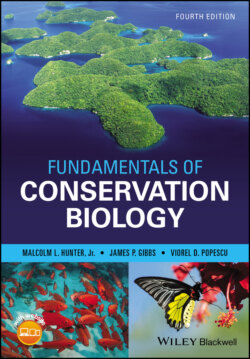Читать книгу Fundamentals of Conservation Biology - Malcolm L. Hunter Jr. - Страница 123
Summary
ОглавлениеGenetic diversity is essentially a measure of the diversity of information a species has encoded in its genes. This information determines the form and function of every organism, and, when expressed as different species, genera, families and so on, underpins all biological diversity on the planet. One way of measuring it “qualitatively” is based on the distribution of different alleles among individuals and can be expressed as polymorphism (which is based on the proportion of genes that have more than one common allele) and heterozygosity (which is based on the proportion of genes for which an average individual is heterozygous). Another way to measure genetic variation is based on continuous or “quantitative” characters such as height, weight, seed set, etc. that are controlled by many genes as well as the environment. Genetic diversity is important for three primary reasons: evolutionary potential, loss of fitness, and utilitarian values. Species with high levels of genetic diversity: (1) are better equipped to evolve in response to changing environments; (2) are less likely to suffer a loss of fitness because of the expression of deleterious recessive alleles in homozygous individuals, among other problems; and (3) offer plant and animal breeders greater scope for developing varieties with specific desirable traits such as resistance to certain diseases. Genetic diversity is eroded by phenomena associated with small population size. First, when a population is reduced to a small size (i.e. it passes through a bottleneck), some genetic variance and uncommon alleles are likely to be lost. Similarly, in populations that remain small for multiple generations, random genetic drift changes the frequency of alleles; this often reduces genetic diversity, particularly when genes become fixed for a single allele. Finally, inbreeding between closely related individuals can diminish genetic diversity. In contrast, breeding between individuals from very different parts of a species’ range can generate offspring adapted to nowhere in particular, a problem called outbreeding depression. When estimating the effects of these processes on populations, it is important to estimate the effective population size, which is often substantially less than the actual population size. Conservation biologists should be concerned with cultural diversity, the information that many animal species, including humans, pass from generation to generation through learning. In summary, genetics plays a special role in conservation biology. Ever more discriminating technologies are continually evolving for assessing genetic variation, underpinning an expanding role for conservation genetics in informing conservation practice.
